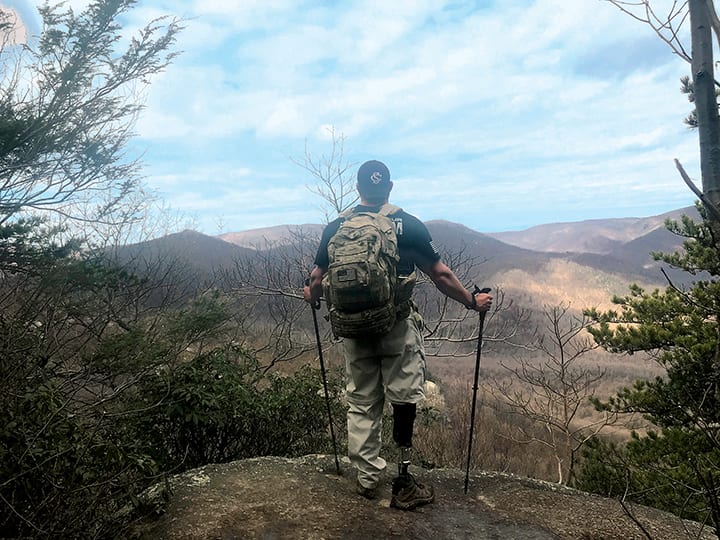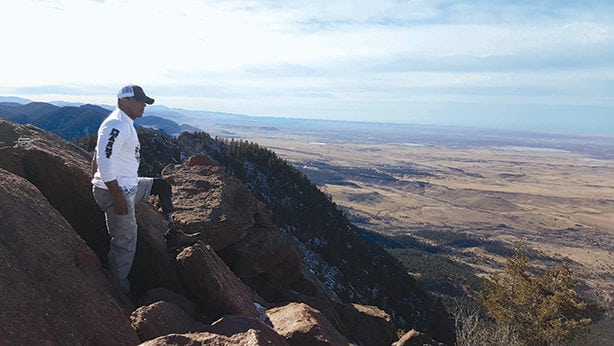By Tony Phillips
It’s finally summer, and ’tis the season for some long overdue outdoor time. But before you go rushing out to take in all that nature has to offer, take a few minutes to think about what you’re getting into. Whether you’re planning on heading to the mountains, the lake, the beach, the desert, or the woods, it pays to be prepared.
Nick Morris is an accomplished outdoorsman and an elite climber. This summer, he’s planning to summit ten 14,000-foot peaks (fourteeners), part of an overall quest to conquer all 53 fourteeners in his home state of Colorado. Morris is a retired Army first lieutenant who spent nearly ten years in the service, including a tour in Afghanistan, where a truck he was traveling in was torn apart by an improvised explosive device that cost Morris his right leg below the knee and left him with limited function in his left leg following an elaborate limb salvage procedure.
“I don’t let my limb loss define me,” says Morris, “but it’s definitely part of who I am now. I accept that my condition is a challenge, but I don’t accept limitations.”
Morris advocates slow, steady training for all amputees seeking to restart an active life. “Initially, whatever it is you’re doing, your body will want to quit. So, you just have to set achievable goals and then keep pushing them. There really is no limit to how much you can achieve.”
Morris didn’t begin by climbing some of North America’s tallest mountains. “There was lots of cardio,” he says. “Conditioning is critical. On a prosthetic leg, you’re using vastly more energy than an able-bodied person just to walk. You can’t go from zero to climbing mountains. You have to build up your fitness.”
For would-be hikers and climbers, Morris recommends building conditioning in the gym, on the treadmill, on the track, or just walking the neighborhood. He also has advice for taking care of limbs—both prosthetic and organic.
“Bring a wrench,” he says. Remembering his climb of Bear Peak, a 12-mile trek, he notes how frequently he tended to his prosthetic leg, checking and tightening bolts, keeping the device adjusted throughout the climb. He also recalls a mistake from that climb. “I developed blisters,” he says, “and just pushed on. That was an important lesson. I know from my military training the importance of taking care of your feet, and I treat my stump like a foot. I’ve conditioned it by building calluses and tolerance, but I stop every mile-and-a-half on any climb to remove the leg and liner to keep my skin dry. I also bring basic wound care supplies in my fanny pack as part of my leg kit.”

Another veteran pushing limits this summer is Bennie Jose Perez, a retired Marine sergeant who lost his right leg above the knee following a training accident and years of failed attempts to salvage the leg after an infection incurred during surgery.
“I broke my kneecap in 1997 and finally had the leg amputated in 2009,” says Perez. “By that time, I’d been struggling with major depression and anxiety for more than a decade. Following the amputation, I began physical therapy and rehabilitation, but I continued to experience severe pain whenever I wore my prosthesis.” Perez underwent multiple nerve blocks, resection of a neuroma, and numerous socket refits and adjustments but still has been unable to use a prosthetic limb due to chronic nerve pain from the distal end of his residual limb to his lower back.
“Being unable to use a prosthetic leg just worsened the depression,” he says. “And in 2013, my doctor told me I was prediabetic and obese. By then I was using a wheelchair to get around, and to address my weight I started by just pushing myself to the stop sign at the end of my block and back, about 200 meters. My wife was there to encourage and support me. It was gradual, just a little bit farther each day, and eventually I was going three miles. Knowing I could do it, I entered my first 5K race on Veterans Day 2013. From then on, pushing myself to new limits has been part of my everyday life.”
Perez has yet to reach his limit. To date, he has completed 16 half marathons, 17 full marathons, and a 62-mile ultramarathon, all in an everyday wheelchair. He will attempt to break his record in December to achieve 100 miles in a 30-hour cutoff time.

In 2015, a friend started a GoFundMe campaign and raised $7,000 in one day to buy Perez a chair better suited for trails. With those funds, he was able to buy a GRIT Freedom Chair, which sells for $2,995, along with spare parts and equipment to support his ever-expanding goals.
The Freedom Chair uses a simple lever drive system that allows users to generate more torque than with conventional manual wheelchairs. The practical design uses off-the-shelf bicycle components, including two chain drives, and combines the efficiency of a handcycle with the small size of a typical manual wheelchair. Users can traverse rough terrain, easily move from grass to sidewalk, conquer dirt trails, and more.
“Having the right equipment definitely helps,” says Perez. “Whether it’s a chair or a limb, or whatever you need to pursue your passion, find a way to get what you need.”
Despite his remarkable achievements as a wheelchair racer, Perez’s primary devotion is to rowing. Since taking up the sport in 2015, he has competed in regattas from Austin, Texas, to Boston, and this summer will be competing in his seventh 5K head race as a member of the Greater Houston Rowing Club. Perez is pursuing a spot on the U.S. Para-Rowing National Team and hopes to qualify for the Paralympics in Paris in 2024, when he will be 51 years old.
Perez shares his passion as a rowing coach at the adaptive recreation center in Houston. “I was inspired by my own coach, Frank Ellis, who taught me archery in 2013, and I just want to give whatever inspiration I can to anyone facing a challenge, whatever it may be.”
Jamie Brown is another aspiring Paralympian. He is currently the top-ranked PT4 para-triathlete in the country. Brown’s summer will entail more miles run, ridden, and swum than he bothers to calculate. What others see as a challenge, Brown sees as normal. He was born without a fibula in his right leg and with just three fingers on his right hand. His right foot was amputated when he was an infant. Notwithstanding that disadvantage, he played baseball at Chapman University, pitching for a team that advanced to the College World Series.
Brown has several items on his checklist for amputees looking to get active, the first of which is, “Anything non-amputees tell you is wrong. Don’t let anyone tell you what you can’t do.”
Secondly, he stresses, “Taper your expectations. Reaching your best is a long process. It takes years, not months. Set day-to-day goals. You don’t need to tell yourself ‘I’m going to run a marathon’ if the first step is ‘I’m going to get out of bed.’”
In addition to his work as a territorial representative with Cascade Orthopedic Supply, a prosthetic and orthotic distributor, Brown works with his wife’s company, Roots and Wings Wellness, helping people of all ages and ability levels improve their holistic fitness. “With some clients,” he says, “I have them lay flat on the floor and stand up, ten times. That’s not easy for a lot of people. It’s a start.”
Like Morris, Brown also stresses the importance of limb care. “Focus on hygiene,” he says. “I lost two weeks of training on two occasions last year by neglecting what I thought were just ingrown hairs that turned into staph infections. Keep your limb clean and dry.”
Brown recommends making a kit for outdoor adventures. “You might need more than water,” he says. “Make a kit. Put a multi-tool in a fanny pack along with any extra socks or other gear you might need spares of.”
Wherever your interests take you this summer, active amputees agree that you can set your own limits. Anything is achievable, but only with practice and preparation. Start by making a plan and work up to your eventual goal. If a five-mile hike is too far to go today, start by going around the block. Mind your equipment, be prepared, and take care of your limb. Preventing mishaps and setbacks will keep you on course, and wherever that course takes you, ignore anyone who says you can’t get there.



